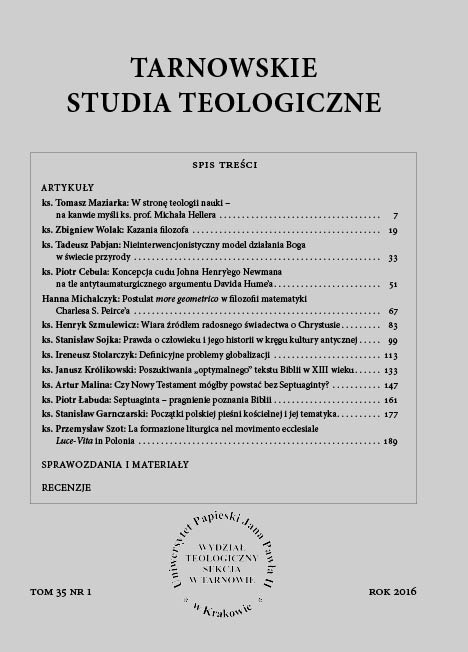Could the New Testament come into being without the Septuagint?
DOI:
https://doi.org/10.15633/tst.1720Keywords:
Septuagint, New Covenant, Canon of the Bible, Epistle to the HebrewsAbstract
The New Testament texts depend on the Septuaginta translation for the grammar and vocabulary that they use. The influence is shown by the numerous quotations according to the most ancient translation of the Old Testament. The relationship between the two main parts of the Bible lies in the common content shared by the authors of their books. The present paper describes the dependence of the name “New Testament” on the Septuagint and demonstrates that its openness favored the reception of the Christian message.References
Euzebjusz z Cezarei, Historia kościelna. O Męczennikach palestyńskich, tłum. A. Lisiecki, Poznań 1924.
Fernández Marcos N., La Bibbia dei Settanta. Introduzione alle versioni greche della Bibbia, Brescia 2000 (rozdział 21: I LXX e il Nuovo Testamento).
Goswell G., The order of the books in the Greek Old Testament, „Journal of the Evangelical Theological Society” 52 (2009) no. 3, s. 465–466.
Harl M., La Septante aux abords de l’ère chrétienne. Sa place dans le Nouveau Testament, [w:] La Bible grecque des Septante: Du judaïsme hellénistique au christianisme ancien, ed. G. Dorival, M. Harl, O. Munnich, Paris 1994, s. 269–288.
Jellicoe S., Septuagint studies in the current century, „Journal of Biblical Literature” 88 (1969), s. 191–199.
Manzi F., Lettera agli Ebrei, Roma 2000.
Septuaginta, czyli Biblia Starego i Nowego Testamentu wraz z księgami deuterokanonicznymi i apokryfami, tłum. R. Popowski, Warszawa 2013.
Stock S. G., Grammar of Septuagint Greek. With selected reading, vocabularies and updated indexes, Boston 1995.
Downloads
Published
Issue
Section
License
Copyright (c) 2016 Artur Malina

This work is licensed under a Creative Commons Attribution 4.0 International License.
Twórca oświadcza, że służą mu prawa autorskie do utworu i że nie są ograniczone w zakresie objętym niniejszym oświadczeniem oraz że utwór jest dziełem oryginalnym i nie narusza praw autorskich innych osób.
Twórca zezwala Uniwersytetowi Papieskiemu Jana Pawła II w Krakowie na nieodpłatne, niewyłączne i nieograniczone w czasie korzystanie z utworu, to jest:
- utrwalanie i zwielokrotnianie: wytwarzanie egzemplarzy utworu techniką drukarską, reprograficzną, zapisu magnetycznego oraz techniką cyfrową;
- obrotu oryginałem albo egzemplarzami, na których utwór utrwalono (wprowadzanie do obrotu, użyczenie lub najem oryginału albo egzemplarzy, publiczne wystawienie, wyświetlenie, a także publiczne udostępnianie utworu w taki sposób, aby każdy mógł mieć do niego dostęp w miejscu i w czasie przez siebie wybranym);
- włączenie utworu w skład utworu zbiorowego;
- udzielanie przez Uniwersytet Papieski Jana Pawła II w Krakowie sublicencji Creative Commons Uznanie autorstwa 4.0 Międzynarodowe (CC BY 4.0).
Uniwersytet Papieski Jana Pawła II w Krakowie udostępnia utwór na Platformie Czasopism należącej do uczelni, na licencji Creative Commons Uznanie autorstwa 4.0 Międzynarodowe (CC BY 4.0) Tym samym uprawnia wszystkich zainteresowanych do korzystania z utworu pod następującymi warunkami:
- zostanie podany autor i tytuł utworu,
- zostanie podane miejsce publikacji (tytuł czasopisma i adres internetowy do oryginalnie opublikowanego utworu).

